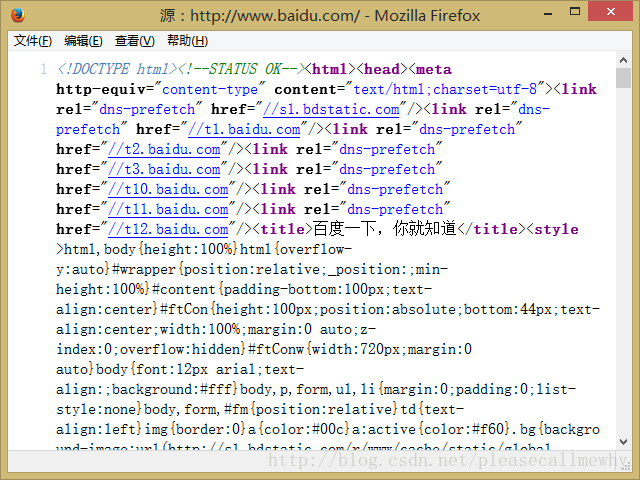 Java
Java
 javaTutorial
javaTutorial
 Write Java with zero foundation and practice Zhihu crawler first with Baidu homepage
Write Java with zero foundation and practice Zhihu crawler first with Baidu homepage
Write Java with zero foundation and practice Zhihu crawler first with Baidu homepage
In the last episode, we talked about the need to use Java to make a Zhihu crawler, so this time, we will study how to use code to obtain the content of the web page.
First of all, if you have no experience with HTML, CSS, JS and AJAX, it is recommended to go to W3C (click me, click me) to learn a little bit.
Speaking of HTML, there is an issue of GET access and POST access.
If you lack understanding of this aspect, you can read this article from W3C: "GET vs. POST".
Aha, I won’t go into details here.
Then, next we need to use Java to crawl the content of a web page.
At this time, our Baidu will come in handy.
Yes, he is no longer the unknown internet speed tester, he is about to become our reptile guinea pig! ~
Let’s take a look at Baidu’s homepage first:

I believe everyone knows that a page like this now is the result of the joint work of HTML and CSS.
We right-click the page in the browser and select "View page source code":

Yes, it's something like this. This is the source code of the Baidu page.
Our next task is to use our crawler to get the same thing.
Let’s take a look at a simple source code first:
import java.io.*;
import java.net.*;
public class Main {
public static void main(String[] args) {
// 定义即将访问的链接
String url = "http://www.baidu.com";
// 定义一个字符串用来存储网页内容
String result = "";
// 定义一个缓冲字符输入流
BufferedReader in = null;
try {
// 将string转成url对象
URL realUrl = new URL(url);
// 初始化一个链接到那个url的连接
URLConnection connection = realUrl.openConnection();
// 开始实际的连接
connection.connect();
// 初始化 BufferedReader输入流来读取URL的响应
in = new BufferedReader(new InputStreamReader(
connection.getInputStream()));
// 用来临时存储抓取到的每一行的数据
String line;
while ((line = in.readLine()) != null) {
//遍历抓取到的每一行并将其存储到result里面
result += line;
}
} catch (Exception e) {
System.out.println("发送GET请求出现异常!" + e);
e.printStackTrace();
}
// 使用finally来关闭输入流
finally {
try {
if (in != null) {
in.close();
}
} catch (Exception e2) {
e2.printStackTrace();
}
}
System.out.println(result);
}
}The above is the Main method of Java simulating Get access to Baidu.
You can run it and see the result:
Aha, it is exactly the same as what we saw with the browser before. At this point, the simplest crawler is ready.
But such a big pile of things may not all be what I want. How can I grab what I want from it?
Take Baidu’s big paw logo as an example.
Temporary need:
Get the picture link of the big paw of Baidu Logo.
First let’s talk about the browser viewing method.
Right-click the image and select Inspect Elements (Firefox, Google, and IE11 all have this function, but the names are different):

Aha, you can see that under the siege of a lot of divs The poor img tag.
This src is the link to the image.
So how do we do it in java?
Please note in advance that in order to facilitate the demonstration of the code, all codes are not encapsulated by classes, please understand.
Let’s first encapsulate the previous code into a sendGet function:
import java.io.*;
import java.net.*;
public class Main {
static String sendGet(String url) {
// 定义一个字符串用来存储网页内容
String result = "";
// 定义一个缓冲字符输入流
BufferedReader in = null;
try {
// 将string转成url对象
URL realUrl = new URL(url);
// 初始化一个链接到那个url的连接
URLConnection connection = realUrl.openConnection();
// 开始实际的连接
connection.connect();
// 初始化 BufferedReader输入流来读取URL的响应
in = new BufferedReader(new InputStreamReader(
connection.getInputStream()));
// 用来临时存储抓取到的每一行的数据
String line;
while ((line = in.readLine()) != null) {
// 遍历抓取到的每一行并将其存储到result里面
result += line;
}
} catch (Exception e) {
System.out.println("发送GET请求出现异常!" + e);
e.printStackTrace();
}
// 使用finally来关闭输入流
finally {
try {
if (in != null) {
in.close();
}
} catch (Exception e2) {
e2.printStackTrace();
}
}
return result;
}
public static void main(String[] args) {
// 定义即将访问的链接
String url = "http://www.baidu.com";
// 访问链接并获取页面内容
String result = sendGet(url);
System.out.println(result);
}
}This looks a little neater, please forgive me for my obsessive-compulsive disorder.
The next task is to find the link to the picture from a lot of things obtained.
The first method we can think of is to use the indexof function to search for String substrings in the string result of the page source code.
Yes, this method can slowly solve this problem, such as directly indexOf("src") to find the starting serial number, and then get the ending serial number in a hurry.
But we can’t use this method all the time. After all, straw sandals are only suitable for walking around. Later, we still need to cut off the prosthetic leg to hold the head.
Please forgive my intrusion and continue.
So how do we find the src of this picture?
Yes, as the audience below said, regular matching.
If any students are not sure about regular expressions, you can refer to this article: [Python] Web Crawler (7): Regular Expressions Tutorial in Python.
Simply put, regular expression is like matching.
For example, three fat men are standing here, wearing red clothes, blue clothes, and green clothes.
The rule is: catch the one in green!
Then the fat green man was caught alone.
It’s that simple.
However, the regular grammar is still extensive and profound. It is inevitable that you are a little confused when you first come into contact with it.
I recommend a regular online testing tool to everyone: regular expression online test.
With regularity as a magic weapon, how to use regularity in java?
The above is the content of writing Java Zhihu crawler with zero foundation. First, practice with Baidu homepage. For more related content, please pay attention to the PHP Chinese website (www.php.cn)!

Hot AI Tools

Undresser.AI Undress
AI-powered app for creating realistic nude photos

AI Clothes Remover
Online AI tool for removing clothes from photos.

Undress AI Tool
Undress images for free

Clothoff.io
AI clothes remover

AI Hentai Generator
Generate AI Hentai for free.

Hot Article

Hot Tools

Notepad++7.3.1
Easy-to-use and free code editor

SublimeText3 Chinese version
Chinese version, very easy to use

Zend Studio 13.0.1
Powerful PHP integrated development environment

Dreamweaver CS6
Visual web development tools

SublimeText3 Mac version
God-level code editing software (SublimeText3)

Hot Topics
 Square Root in Java
Aug 30, 2024 pm 04:26 PM
Square Root in Java
Aug 30, 2024 pm 04:26 PM
Guide to Square Root in Java. Here we discuss how Square Root works in Java with example and its code implementation respectively.
 Perfect Number in Java
Aug 30, 2024 pm 04:28 PM
Perfect Number in Java
Aug 30, 2024 pm 04:28 PM
Guide to Perfect Number in Java. Here we discuss the Definition, How to check Perfect number in Java?, examples with code implementation.
 Random Number Generator in Java
Aug 30, 2024 pm 04:27 PM
Random Number Generator in Java
Aug 30, 2024 pm 04:27 PM
Guide to Random Number Generator in Java. Here we discuss Functions in Java with examples and two different Generators with ther examples.
 Armstrong Number in Java
Aug 30, 2024 pm 04:26 PM
Armstrong Number in Java
Aug 30, 2024 pm 04:26 PM
Guide to the Armstrong Number in Java. Here we discuss an introduction to Armstrong's number in java along with some of the code.
 Weka in Java
Aug 30, 2024 pm 04:28 PM
Weka in Java
Aug 30, 2024 pm 04:28 PM
Guide to Weka in Java. Here we discuss the Introduction, how to use weka java, the type of platform, and advantages with examples.
 Smith Number in Java
Aug 30, 2024 pm 04:28 PM
Smith Number in Java
Aug 30, 2024 pm 04:28 PM
Guide to Smith Number in Java. Here we discuss the Definition, How to check smith number in Java? example with code implementation.
 Java Spring Interview Questions
Aug 30, 2024 pm 04:29 PM
Java Spring Interview Questions
Aug 30, 2024 pm 04:29 PM
In this article, we have kept the most asked Java Spring Interview Questions with their detailed answers. So that you can crack the interview.
 Break or return from Java 8 stream forEach?
Feb 07, 2025 pm 12:09 PM
Break or return from Java 8 stream forEach?
Feb 07, 2025 pm 12:09 PM
Java 8 introduces the Stream API, providing a powerful and expressive way to process data collections. However, a common question when using Stream is: How to break or return from a forEach operation? Traditional loops allow for early interruption or return, but Stream's forEach method does not directly support this method. This article will explain the reasons and explore alternative methods for implementing premature termination in Stream processing systems. Further reading: Java Stream API improvements Understand Stream forEach The forEach method is a terminal operation that performs one operation on each element in the Stream. Its design intention is





